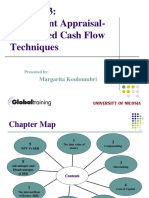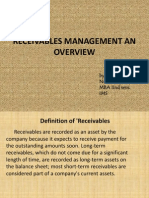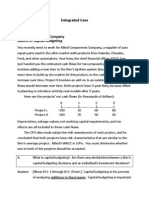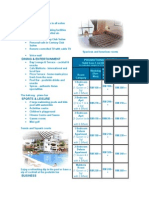Calculating Net Present Value and IRR Using Excel
Uploaded by
Telemetric SightCalculating Net Present Value and IRR Using Excel
Uploaded by
Telemetric Sight21/09/2013
Calculating Net Present Value and IRR Using Excel
Calculating Net Present Value Suppose you want to calculate the net present value for the following problem: You are considering an investment in a machine that costs $100,000 and the additional cash inflows (net income + depreciation) from the machine will be $40,000, $ 50,000, and $60,000 over the next three years. The firm's cost of capital is 16%. Suppose you enter the data in an Excel spreadsheet as follows: -100,000 in cell C1 40,000 in cell C2 50,000 in cell C3 60,000 in cell C4 To calculate the net present value, go to theFunction Wizard. The function you are going to use is in the function category of FINANCIAL and is NPV. You will have to provide the following information:
RATE: .16 VALUE 1: C2:C4 For rate, enter the cost of capital, .16 For VALUE 1 enter the values that get discounted, C2:C4 Do not enter the initial cost (C1) since it does not get discounted. The value you will get from Excel for the above problem is 110,080.36. To get the net present value, you have to subtract the 100,000 (remember that adding a negative number is the same as subtracting) from the 110,080.36 and your answer is: 10,080.36.
academic.brooklyn.cuny.edu/economic/friedman/npvirr.htm 1/2
21/09/2013
Calculating Net Present Value and IRR Using Excel
To get the Profitability Index (PI) , divide the present value of the inflows, 110,080.36 by the initial cost (100,000). The PI is1.10. This means that every invested present value dollar yields $1.10 in present value inflows. If the net present value is positive, the PI is greater than 1.
Calculating Internal Rate of Return (IRR)
Go to the function wizard and get the function IRR. You will have to provide the following information: VALUES: C1:C4 GUESS: .10 For Values, enter all the flows, including the cost. The cost should be a negative number. For Guess, enter any value. If you do not want to guess, use .10. The reason you are asked to guess is because there may be several IRR's. In class, you will learn when this might happen. Make sure that you get the answer to two decimal places. You can get two decimal places by formatting the cells or by going to the menu bar and clicking on the "increase decimal" icon. The answer is 21.65%. If the IRR is greater than the cost of capital, you go ahead with the investment. Since 21.65% is greater than 16%, you invest in the machine.
academic.brooklyn.cuny.edu/economic/friedman/npvirr.htm
2/2
You might also like
- Management Accounting: MBA First Year CR23No ratings yetManagement Accounting: MBA First Year CR2328 pages
- Chapter - 8: Capital Budgeting DecisionsNo ratings yetChapter - 8: Capital Budgeting Decisions44 pages
- ACCA AiD - NPV (Net Present Value) Advantages and DisadvantagesNo ratings yetACCA AiD - NPV (Net Present Value) Advantages and Disadvantages2 pages
- Financial Management Test 2: Answer ALL Questions50% (2)Financial Management Test 2: Answer ALL Questions3 pages
- Syllabus FINA 6092 - Advanced Financial ManagementNo ratings yetSyllabus FINA 6092 - Advanced Financial Management5 pages
- A Case Study On Changing Depreciation Methods and Quality of Disclosure0% (1)A Case Study On Changing Depreciation Methods and Quality of Disclosure13 pages
- Financial Accounting: A Managerial Perspective: Sixth EditionNo ratings yetFinancial Accounting: A Managerial Perspective: Sixth Edition15 pages
- Adjusted Present Value Method of Project AppraisalNo ratings yetAdjusted Present Value Method of Project Appraisal7 pages
- Bangladesh Cost Accounting Standards (BCAS)No ratings yetBangladesh Cost Accounting Standards (BCAS)5 pages
- Chemalite Group - Cash Flow Statement - PBT100% (1)Chemalite Group - Cash Flow Statement - PBT8 pages
- Chapter One Introduction To Financial Modeling and Valuation Modified100% (1)Chapter One Introduction To Financial Modeling and Valuation Modified21 pages
- Understanding Internal Rate of Return (IRR) and Its Calculation in ExcelNo ratings yetUnderstanding Internal Rate of Return (IRR) and Its Calculation in Excel2 pages
- PEST Analysis: Downloaded From The Times 100 EditionNo ratings yetPEST Analysis: Downloaded From The Times 100 Edition1 page
- Business Victoria Marketing Plan TemplateNo ratings yetBusiness Victoria Marketing Plan Template32 pages
- Kemajuan Ekonomi: Kemajuan Ekonomi Inisiatif 1malaysia Transformasi Politik Penglibatan Kepimpinan GlobalNo ratings yetKemajuan Ekonomi: Kemajuan Ekonomi Inisiatif 1malaysia Transformasi Politik Penglibatan Kepimpinan Global3 pages
- How Much of My Pension Can I Spend? (After Tax and Increasing With Inflation)No ratings yetHow Much of My Pension Can I Spend? (After Tax and Increasing With Inflation)22 pages
- How Many More Years Must I Work To Have $1 Million at Retirement?No ratings yetHow Many More Years Must I Work To Have $1 Million at Retirement?3 pages
- A Mobile Disaster Management System Using The Android TechnologyNo ratings yetA Mobile Disaster Management System Using The Android Technology10 pages
- Break Even Point Analysis-Definition, Explanation Formula and Calculation100% (2)Break Even Point Analysis-Definition, Explanation Formula and Calculation5 pages













































































